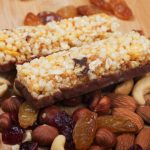 Everywhere you look a new fitness food is being touted. Try this now! Eat this to lose weight! Lose weight without exercise! It’s all propaganda so consumers buy more. But not only are consumers wasting their money, they aren’t seeing the results they were promised. We’re continuously bombarded with the “latest and greatest” thing, but are these products actually helping us or are they hurting us?
Everywhere you look a new fitness food is being touted. Try this now! Eat this to lose weight! Lose weight without exercise! It’s all propaganda so consumers buy more. But not only are consumers wasting their money, they aren’t seeing the results they were promised. We’re continuously bombarded with the “latest and greatest” thing, but are these products actually helping us or are they hurting us?
Everyone wants to get thin quick and companies know this. They brand their food items as ‘fitness foods’ so you believe that by simply eating them, you’re doing your body good. But these fitness food fads are coming undone by recent research.
Study: Fitness foods lead to over-eating and lack of exercise
Advertisement
By now you know the recipe for weight loss – eat well and physical activity. Exercise and proper diet go hand-in-hand to promote weight loss. Weight-loss foods alone don’t do much.
 The latest findings in the area of fitness foods and weight loss are published in the Journal of Marketing Research. Authors of the study wanted to uncover consumer habits based on eating fitness foods.
The latest findings in the area of fitness foods and weight loss are published in the Journal of Marketing Research. Authors of the study wanted to uncover consumer habits based on eating fitness foods.
Participants in the study were given either a ‘fitness’ snack or trail mix. The packaging of the fitness snack portrayed running shoes to signify it was meant to be a fitness food. At first the participants were given eight minutes to pick a snack, eat it and rate it. Another part of the study gave them the option of going on a stationary bike after they consumed the snack.
They found not only that weight-conscious participants ate more of the fitness snack, but they spent less time on the bike. The study’s authors suggested that manufacturers of fitness foods need to go a step further to promote staying fit. They suggested promotions for gym passes or fitness tips. Simply labeling themselves as a fitness food is not enough.
Fitness foods and weight loss
Although a food or snack might seem to promote healthy habits, the study shows that people are not engaging in the actual fitness part.
This can be harmful, because as the researchers uncovered, consumers will actually eat more of the so-called healthy snack, which won’t help their weight-loss objectives. It’s important to understand that food and exercise must work together to achieve weight-loss goals.
Why exercise is important along with fitness foods
 Fitness foods are meant to be burned off. These snack items tend to have a lot of carbohydrates as well as protein and fat. Without exercise these fitness foods will do the exact opposite of what you need them to do – they will make you gain weight.
Fitness foods are meant to be burned off. These snack items tend to have a lot of carbohydrates as well as protein and fat. Without exercise these fitness foods will do the exact opposite of what you need them to do – they will make you gain weight.
Other than weight loss, exercise can benefit the body in many ways. Some health benefits you can obtain from exercise include:
- Better heart health
- Stronger bones
- Greater range of motion and flexibility
- Reducing the risk of illness like diabetes
- More energy
- Improving self-confidence
- Extending your life.
As you can see exercise is beneficial for overall health and should always take place – whether you enjoy fitness foods or not.
So keep in mind the next time you’re looking to buy a snack: Just because the packaging looks active doesn’t mean you’ll obtain the results without being active yourself.
Related Reading:
How regular exercise affects your mood
At some point in our lives, we’ve felt sad, stress, angry and simply down in the dumps. Usually these emotions have been tied to an event and so they tend to pass as time heals. But if you’re feeling low over a longer period, you may need to take action to boost your mood. Continue reading…
Advertisement
Exercise like this for good health
Generally, those intense, interval-style exercises – brief bouts of physically exertion broken up by periods of recovery – have been proven to lead to fitness and good health. But for people new to exercise or with mobility challenges, high-intensity interval training isn’t a one-size-fits-all approach to good health. Until now, that is. Continue reading…
Sources:
http://www.choosemyplate.gov/physical-activity/why.html
http://arogyamasthu.com/fitness-foods-may-cause-consumers-to-eat-more-exercise-less/
http://journals.ama.org/doi/10.1509/jmr.12.0429
http://www.sciencedaily.com/releases/2015/06/150623072424.htm
